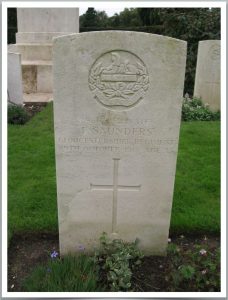1st Battalion, Gloucestershire Regiment

Frederick Saunders was born at Gloucester in 1893.
He left his occupation as a Doorman on 13 July 2012 and joined the Gloucestershire Regiment after signing Attestation for seven years, with an additional five in the Reserve.
He was a short man, only 5 feet 5½ inches tall and weighed only 8.5 stone.
He joined the Gloucestershire Regiment on 17 July 1912 at Horfield Barracks, Bristol and after training was posted to the 1st Battalion of the Gloucestershire Regiment on 14 November 1912 and he served in the UK at Bristol, Portsmouth and Bordon until 12 August 1914.
The 1st Glosters sailed for France on 13 August 1914, to join the BEF. In late October the 1st Glosters were in action in the Gheluvelt area of the Ypres Salient.
According to a Medical Board Report Saunders was ‘in action at Ypres on 28 October 1914.
He was wounded in the calf of right leg and captured by Germans. He was left in a field for six days in a shell hole. A field dressing was applied once and he was not touched afterwards.
Leg was afterwards amputated by the Germans 3” above knee’ (at Ghent).
On 17 February 1915 Saunders returned to the UK as part of a prisoner exchange involving those who were incapacitated as a result of wounds.
The Cheltenham Chronicle of 20 February 1915 reported that he was one of 210 ‘rank and file’ exchanged for German prisoners on the grounds of unfitness for further service.
He was sent to Queen Alexandra’s Military Hospital (Millbank, London); complications with his amputation stump necessitated a further operation on 19 March 1915.
An Invaliding Board recommended his discharge from the Army on 12 May 1915 and on the 7 July 1915, it was confirmed that he as no longer physically fit for service.
He was warded a pension of 25 shillings (£1.25) per week.
In October 1915 he was supplied with an Artificial Appliance (probably a leg) at a cost of £12 12 shillings (£12.60) – about £750 in 2009.
He was the recipient of a Silver War Badge.
Frederick Saunders died on 29 October 1918, aged 25 and is buried in the First World War Graves plot at Gloucester Old Cemetery.
Research by Graham Adams 10 May 2014 (revised)
